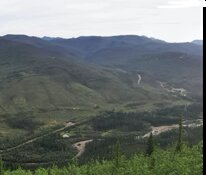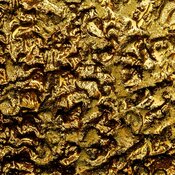Eric Coffin: Obviously, with the resource sector, you're talking a pretty broad spectrum of companies in terms of types of resources they focus on, but also level of development and overall risk. If I was fairly risk adverse (and the presumption that you're sitting on the sidelines means you probably are), I suppose I'd go more towards the senior producer end of the sector. That's not the end we normally put a major focus on. We made the decision some years ago that our strong suit was exploration and development-level companies. We do follow a number of producers because they have taken over companies we followed. This is nice, since it adds producers to the list at very low entry prices for subscribers, but we don't usually initiate coverage on majors. You can certainly make the case that gold producers and base metal producers really haven't seen the kind of gains that seem rational given what the metals themselves have done in the past year. So there is room there for gains.
You'd want to sit down and look through a company's quarterly financials and read the MD&A (Management Discussion and Analysis). You're looking for good performance, but you also want to see evidence that they're going to expand production because that gives you a bit of a cushion. If metal prices are moving up strongly, anyone that produces them should see some share price gain. It's nicer and safer if the company is also growing production. That should allow top-line revenue to grow even if metal prices are taking a breather.
Next down the track would be development-level stocks. These are companies that have a resource that is being expanded and/or moved forward towards a production decision. Companies at this level are popular takeover targets for majors. We've seen more merger and acquisition activity in both the gold and the base metal side and I think that's going to accelerate. When markets fell in 2008, explorers and developers were hit the hardest. Few people other than us expected them to bounce back. Large producers thought they had plenty of time and were waiting for the perfect ratio between their share price and that of the company they were targeting. Well, it turns out that explorer shares moved back up quickly. Producers held off, but we think they are now accepting the fact that the perfect ratio they were hoping for may never arrive. There are new players in the market like the Chinese, who have been very aggressive. Larger companies are starting to bid on juniors before someone else beats them to it. We've seen a couple of recent takeover offers, including a company on our list, that we did not expect this soon. If majors have decided they need to move on these transactions sooner we will probably see much more M&A activity later this year.
TGR: Are you looking at high-risk/high-reward projects and potential acquisition plays with regard to the juniors?
EC: Yes, both. There are two schools of thought in the sector. There are guys that look for projects where they can make a discovery and carry out high-impact exploration projects. They are usually hoping for an eventual takeover offer as the end game. The other common approach is the joint venture model. A company will try and accumulate a large number of prospects and try to option them to other companies so someone else is spending the money. Joint venturing secondary projects is a good idea, but overall we would favor companies working their own marquee projects rather than the pure joint venture model. If the markets are good and they have been lately, strong management groups can raise money. Successful projects will allow for more fundraising on better terms. A company's net dilution is often less this way than through an option agreement where the company gets earned down to a minority interest. The other advantage to working your own projects is that you have control of the news flow, which is usually not the case in a joint venture, especially with a major.
When we looked at the market this time last year, we decided that there was still risk capital around. There were companies with cheap share prices, money in the bank and projects that, to us at least, had obvious potential to deliver really strong exploration news. We started following a gold company about a year ago called East Asia Minerals Corp. (TSX.V:EAS) at about $.40. The project, Miwah, looked fantastic, but the market was just too afraid to really jump on anything. The stock traded good volume and a lot of our subscribers accumulated it, but the share price really didn't move until drilling started late last summer. EAS released incredible trenching results but the market reaction was "show me drill holes. I don't want to get near anything until I see that." Drill results did begin to arrive soon after and they have been as good or better than we hoped. Drilling is continuing to expand the main zone and the company is preparing several nearby areas for drill testing. EAS is looking more and more like a prime takeover candidate. One day we think some major will decide Miwah is a must-own asset and show up and take the whole company out.
TGR: Are you and your brother still shareholders in East Asia?
EC: Yes we are. I think I own more now than I did six months ago and the stock is now over $7. That is a big market value for the ounces EAS can put on the table now but, to me Miwah looks like it has realistic potential to host 10 million ounces of gold and possibly a lot more. Projects like that do not come around very often. So far everything has sort of gone right. I would like to see them accelerate the exploration work, but I think that will come. The company does not have a 43-101 resource but the market can see the main zone is expanding and still open and those other zones will soon be drilled, too. It's that potential for continued rapid growth in the asset that is driving the share price.
Another example of a company like that is Riverstone Resources Inc. (TSX.V:RVS), which we have followed longer. They had a million-ounce gold resource on their marquee project in Burkina Faso, West Africa, but the market didn't care. It took the cachet of a new discovery area to get the market excited about the stock. That reaction is the reason we've been focused on discovery stories lately. The project is called Karma and the discovery area, Nami, is new and several kilometers from any of the existing zones. There was a gold rush by local miners in this area on their Karma project. RVS went in and did extensive sampling of the artisanal shafts and waste dumps. The results were quite good and indicated this new zone could have large scale. The stock has moved from the low $.20 range to $1.00 and settled in the $.80 range on this news. It's traded large volumes and management took advantage of the market attention to raise another $10 million, which puts the company in good shape financially.
TGR: Do you think a company like that may be a little over-capitalized for what they have at the moment?
EC: I think you can certainly make the argument that it's gotten ahead of itself partially because the initial results look impressive. The company has raised another $10 million but, strictly speaking, it has the same ounces in the ground it did four months ago. At that point it was undervalued, but it's fair to say it will take some strong drill holes to live up to the current market value. We still have the stock rated as a buy, but we have also told our readers that they should be trading enough stock out to bring their holding cost down substantially. We tell our readers constantly, in fact, that the ideal situation is one where you see potential value before the market. If the market then marks up a stock by a large amount before new results arrive, as it has in this case, you have an opportunity to sell enough to have a very low cost and be playing with house money. You might leave some money on the table, but it's never a bad thing to take a bit of profit.
TGR: If they do pull those drill holes that you and others suspect could bring some decent results, could the market cap then double and support the shareholders?
EC: Absolutely. We don't know what will be in the drill holes, but the shaft and dump sampling, especially the latter, were quite positive. The higher probability outcome is that the holes are good. Sampling was done over a 500 by 300 meter area and that area is open in two to three directions. In short, the zone has good scale potential. If they get good grades and widths Nami can add a large number of ounces to the resource for Karma. There is a million-ounce resource already and a large addition to that should significantly improve the overall economics. In addition to that, there were a number of high-grade results in the sampling done prior to drilling. This is a market that is reacting strongly to good drill holes and we could see a repeat of that if RVS hits higher grades. Right now it has scale potential and "newness" driving it. It could easily head higher still after a good set of drill holes but it does need those holes.
TGR: And you're one of those people that are excited about it right now?
EC: Yes. We've always liked the management group and the project set, not just the Karma project alone. RVS was one of those stocks that got bombed out like everybody did last year. It was a painful process for them to raise enough money to get going again. They've got a fair amount of momentum now though and have the money to carry out extensive programs not just on Karma, but on a couple of other projects too if they want. They might have two or three other good projects but nobody is going to care until they are delivering news from them. We harp on this all the time. News flow is really, really important. If you're going to play earlier-stage exploration stocks, you want to get in at the start or before the start of a drill program and not at the end. You may see in a news release something about a hot drill hole and you say "Oh wow, what's that all about?" You read it further. One of the first things you should be scanning for in addition to the results is where they are in the drill program. If you get to the last paragraph and realize that they just reported their last hole of the program and they won't be back for four months unless the hole is unbelievable, it's pretty unlikely the stock is going to stay where it is. You'll probably get it cheaper later. Where you are in the news flow is really important on the exploration side.
TGR: The companies usually have an idea of when that news is going to happen. How does the average retail or even the institutional investor know when to get in just before that news pops?
EC: Well, one way to do it is to get a subscription to a good newsletter. The other way to do it is to phone the company and ask them where they are in the drill program. What is their lab turnaround time? That varies quite a bit. There are areas where guys are getting results back in two weeks and others where it's taking two months. It just depends on how many companies are active in an area and how many local labs there are to handle the work. The companies will usually give you a good indication of that if you phone up and ask them. Ask them when they think they can start getting news out and are they going to be releasing news every three, or 10 holes or even just once at the end of the drill phase. Most companies don't make a secret of this information and will tell you to the best of their ability if you ask. If the market's good and it's being good for some of these exploration stories, you start seeing a fairly significant amount of anticipatory buying as the expected date of an important news release approaches. That's probably mainly coming from people that have contacted the company and asked the questions.
TGR: Are you looking at platinum or palladium at all right now?
EC: We have followed platinum and palladium explorers in the past, and currently have two producers on the list. I'm reviewing a couple but there are not a huge number of strong platinum group elements (PGE) exploration stories around. I like the way both metals are trading and the market for both palladium and platinum are clearly tightening up. The recent introduction of platinum and palladium bullion ETFs is another positive factor, as these two ETFs drew over $500 million in a few weeks. Almost all of the significant platinum deposits are in one place, South Africa. Large companies that control most of the platinum camps in South Africa have huge resources, but most of it is in relatively narrow zones with tricky geometry; it's not cheap to produce and capital costs tend to be high. That's another way of saying we don't expect a flood of it into the market. Russia is a big palladium producer but it's impossible to tell if they have large aboveground inventories though they do not appear to at the moment at least.
One of the two producers we follow is North American Palladium Mines (TSX:PDL; NYSE.A:PAL), which is just re-starting their mine in Ontario again. They estimated production costs of $350/oz of palladium, so they should do ok with prices now above $500/. PDL entered the Hard Rock Advisory (HRA) list when it merged with a small gold developer on our list. The gold operation is now in production so they have gold revenues as well. It's well priced and, like most producers, the time to accumulate is after a few bad days for metal prices when you can put in lower bids. The other one on the HRA list is called Eastern Platinum Ltd. (TSX:ELR;JSE:EPS) in Toronto. They have been a consolidator in the eastern limb of the Bushel Complex. They are in production now, but they do have a very large amount of stock out and two years of lower prices sapped the balance sheet. We took profits a couple of years back at $2.50 but have left it on the list. They are working in increase production this year. We expect ELR to trade in line with PGE prices. The upside of the company's large share float is that it's extremely liquid and easy to trade. We are on the lookout for a good platinum exploration play but they're not very common. There are a couple in South America and a couple of earlier stage ones in the Canadian Shield but that is about all.
TGR: Thanks very much for your time, Eric.
EC: You're very welcome. We've set up a special page on our website where you readers can access a set of complimentary recent issues of all three HRA publications and special pricing on some of our products if they are interested. This can be found at www.hraadvisory.com. Please visit us there and see what we do.
Eric Coffin and his brother David are the co-editors of the HRA (Hard Rock Analyst) family of publications. David is the "rocks side" of HRA, and has been active in mining exploration for over 30 years in roles spanning prospecting through feasibility studies, and now markets commentary. Responsible for the "financial analysis" side of HRA, Eric has a degree in Corporate and Investment Finance. He has extensive experience in merger and acquisitions and small company financing and promotion. For many years he tracked the financial performance and funding of all exchange listed Canadian mining companies and has helped with the formation of several successful exploration ventures.
Eric was one of the first analysts (along with David) to point out the disastrous effects of gold hedging and gold loan capital financing (1997) and to predict the start of the current secular bull market in commodities based on the movement of the U.S. dollar (2001) and the acceleration of growth in Asia and India.
David logs, literally, hundreds of thousands of miles every year, visiting exploration sites on six continents in order to bring back the real goods for HRA subscribers. Eric and David can be reached at hra@publishers-mgmt.com or through their website at www.hraadvisory.com.
Want to read more exclusive Gold Report interviews like this? Sign up for our free e-newsletter, and you'll learn when new articles have been published. To see a list of recent interviews with industry analysts and commentators, visit our Expert Insights page.
DISCLOSURE:
1) Ellis Martin of The Gold Report conducted this interview. He personally and/or his family own shared of the following companies mentioned in this interview: None.
2) The following companies mentioned in the interview are sponsors of The Gold Report: None.
3) Eric Coffin: I personally and/or my family own shares of the following companies mentioned in this interview: East Asia Minerals, Riverstone Resources and North American Palladium. I personally and/or my family are paid by the following companies: HRA Advisories never accepts compensation in any form from companies we choose to feature in our subscriber-only publications.










































